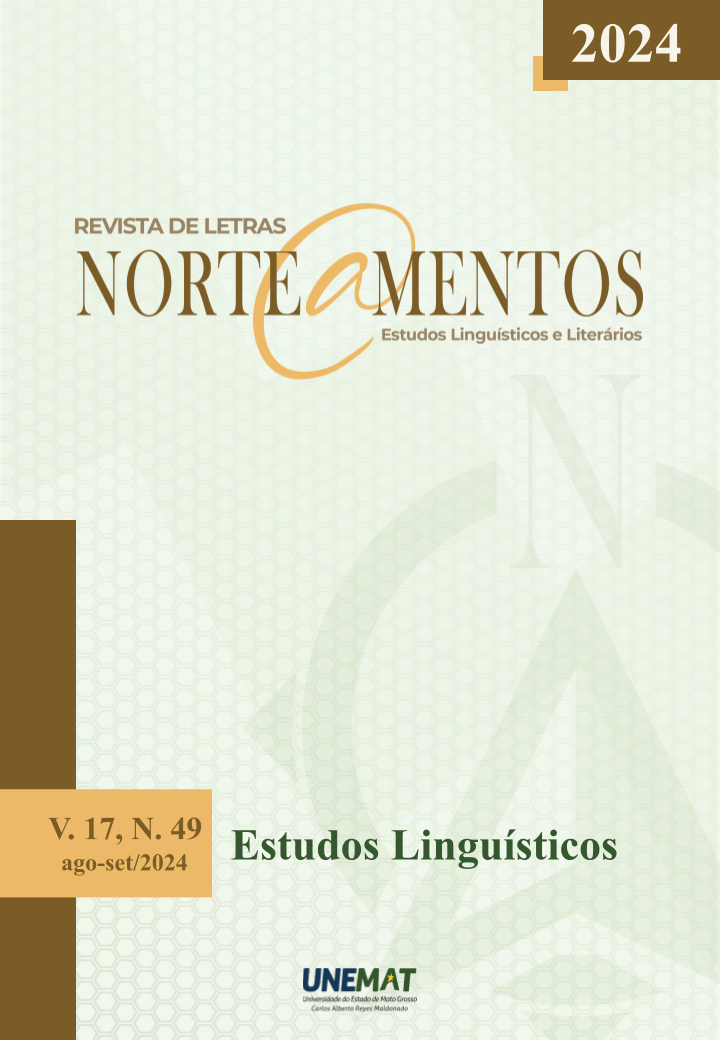DESENVOLVENDO A COMPETÊNCIA EM LÍNGUA PORTUGUESACOMO SEGUNDA LÍNGUA ENTRE CRIANÇAS CHINESAS EMMACAU:
UM ESTUDO EMPÍRICO EM UM JARDIM DE INFÂNCIACOM O PORTUGUÊS COMO LÍNGUA DE INSTRUÇÃO
DOI:
https://doi.org/10.30681/rln.v17i49.12336Palavras-chave:
crianças chinesas , português como segunda língua, estágios de desenvolvimento da competência na segunda línguaResumo
A presente pesquisa tem como objetivo evidenciar, por meio de observações, como as crianças chinesas desenvolvem sua competência em língua portuguesa como segunda língua em um jardim de infância em Macau, onde o português é a língua de instrução. Os resultados indicam que, embora estejam imersas no mesmo ambiente linguístico, as crianças chinesas observadas estão em diferentes estágios de desenvolvimento da competência na segunda língua, conforme proposto por Tabors (2008). Fatores motivacionais e emocionais, assim como a organização do conteúdo didático e das atividades em sala de aula, desempenham um papel crucial no processo de desenvolvimento de competências em português pelas crianças chinesas.
Downloads
Referências
ABRUNHOSA, M. M. G. A canção infantil na didática do português língua estrangeira/ língua segunda. Lisboa, 2006. Tese de Mestrado - Faculdade de Letras, Universidade de Lisboa.
BAIGENT, M. Speaking in Chunks: An investigation into the use of multi-word phrases in spoken language by advanced learners of English. Birmingham, 1996. MSc Thesis in Teaching English - Aston University.
BARZSÓ, Balint. Introducing English as a foreign language in pre-school situations. Berlin: VDM Verlag Dr. Müller, 2008.
CAI, Lixia [蔡丽霞]. Deixando as crianças aprenderem inglês em um ambiente descontraído
e agradável - uma breve discussão sobre o importante papel do ambiente linguístico na
aquisição de uma segunda língua pelas crianças [让儿童在轻松愉悦的环境中进行英语学
习——浅谈语言环境对于儿童二语习得的重要作用]. Informação de Ciência e
Tecnologia de Heilongjiang [黑龙江科技信息], v. 34, p. 213-213, 2008.
COPPLE, Carol; BREDEKAMP, Sue. Developmentally appropriate practice in early childhood programs: Serving children from birth through age 8. Washington, D.C.: National Association for the Education of Young Children, 2009.
COPPLE, Carol; SIGEL, Irving E.; SAUNDERS, Ruth. Educating the young thinker: Classroom strategies for cognitive growth. New York: Routledge, 2013.
FANTINI, Alvino E. Language acquisition of a bilingual child. San Diego: College-Hill Press, 1985.
FERNANDES, Elba Cecília de Souza. Práticas lúdicas no processo de ensino de inglês para
crianças: a importância dos jogos e brincadeiras no ensino de inglês para crianças do fundamental i. Revista CBTecLE, v. 5, n. 1, p. 371-382, 2021.
FILGUEIRAS, Marta Sofia Carreiro. O espaço e o seu impacto educativo: quais as principais características da gestão e organização do espaço sala em educação infantil.
Lisboa, 2010. Tese (Mestrado em Administração e Gestão Educacional) - Universidade Aberta.
GASS, Susan M.; SELINKER, Larry. Second language acquisition: An introductory course. New York: Routledge, 2008.
GIRARD, Marie. The functions of formulaic speech in the L2 class. Pragmatics, v.14, n.1, p. 31-53, 2004.
GROSSO, Maria José. O Uso do Português na Paisagem Linguística de Macau. In NASCIMENTO, G. (org.). Fotografias de Linguística Aplicada. Ensino Crítico de Língua para o Século XXI. São Paulo: Pimenta Cultural, 2023, p. 34-53.
HSIEH, Ming Fang. “My mom makes me to learn English”: Power, system, instruction and quality of early childhood English language education in Taiwan. Bloomington: Indiana University Bloomington, 2006.
HUDELSON, Sarah. The role of native language literacy in the education of language minority children. Language Arts, v. 64, n. 8, p. 827-841, 1987.
KRASHEN, Stephen D. Principles and practice in Second Language Acquisition. London: Prentice-Hall International, 1987.
MANEVA, B.; GENESEE, F. Bilingual babbling: evidence for language differentiation in dual language acquisition. In SKARABELA, B.; FISH, S.; DO, A. (orgs.), BUCLD 26: Proceedings of the 16th Annual Boston University Conference on Language Development. Somerville, MA: Casadilla Press, 2002, v. 1, p. 383-392.
MCLAUGHLIN, Barry. The monitor model: Some methodological considerations. Language learning, v. 28, n. 2, p. 309-332, 1978.
PELLEGRINI, A. D.; BOYD, B. The role of play in early childhood development and education: Issues in definition and function. In SPODEK, B. (org.) Handbook of research on the education of young children. New York: Macmillan, 1993, p. 105-121.
PELLEGRINI, A. D.; GALDA, L. Longitudinal relations among preschoolers’ symbolic play, metalinguistic verbs, and emergent literacy. In CHRISTIE, J. (org.) Play and early literacy development. Albany, NY: State University of New York Press, 1991, p. 47-68.
PIRES, Simone Silva. Vantagens e desvantagens do ensino de língua estrangeira na educação infantil: um estudo de caso. Porto Alegre, 2001. Tese (Mestrado em Estudos da Linguagem) – Instituto de Letras, Universidade Federal do Rio Grande do Sul.
PRAMLING, Ingrid. Learning about “the shop”: An approach to learning in preschool. Early Childhood Research Quarterly, v. 6, n. 2, p. 151-166, 1991.
ROSEBERRY-MCKIBBIN, Celeste. Multicultural students with special language needs. Oceanside, CA: Academic Communication Associates, 1995.
SAVILLE-TROIKE, Muriel. Dilingual discourse: The negotiation of meaning without a common code. Linguistics, 25, p. 81-106, 1987.
SCHRADER, Carol Taylor. Symbolic play as a curricular tool for early literacy development. Early Childhood Research Quarterly, v. 5, n. 1, p. 79-103, 1990.
SMILANSKY, Sara; SHEFATYA, Leah. Facilitating play: A medium for promoting cognitive, socio-emotional and academic development in young children. U.S.A.: Psychosocial & Educational, 1990.
TABORS, Patton O. Panos: A case study of a bilingual child. Cambridge, 1982. Unpublished manuscript - Harvard Graduate School of Education.
TABORS, Patton O. One child, two languages: a guide for early childhood educators of children learning English as a second language. Maryland: Paul H. Brookes Pub. Co., 1997/2008.
Downloads
Publicado
Edição
Seção
Licença
Copyright (c) 2024 Revista de Letras Norte@mentos

Este trabalho está licenciado sob uma licença Creative Commons Attribution 4.0 International License.
Os direitos autorais dos artigos publicados pertencem à Revista de Letras Norte@mentos e seguem o padrão Creative Commons (CC Atribution 4.0), que permite o remixe, a adaptação e criação de obras derivadas do original, mesmo para fins comerciais

